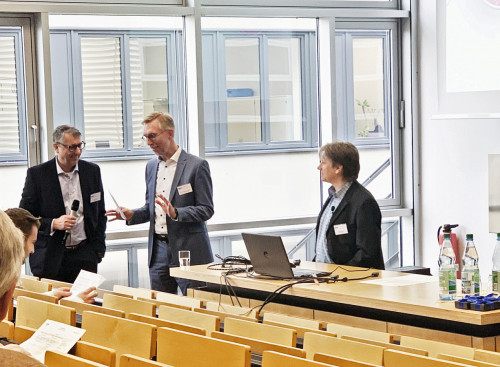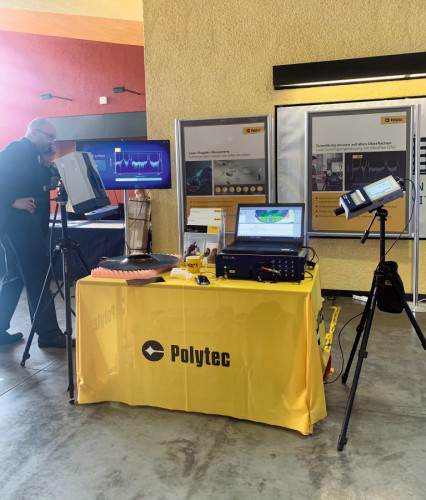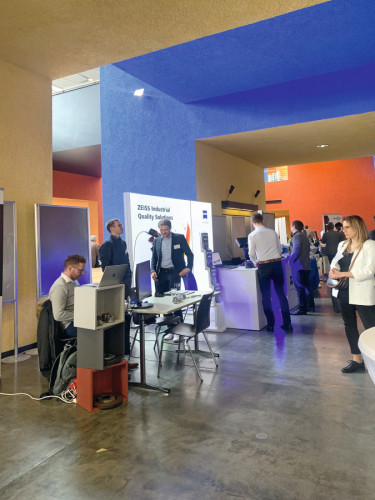The material as a substrate is a central component of the process for electroplating and surface technology. The Materials Technology Colloquium presents innovations relating to the substrate as well as new electroplating technology findings. The 23rd edition of the event took place at the end of March in Chemnitz. It was organized by the Institute of Materials Science and Engineering at Chemnitz University of Technology.
In his welcoming address, TU Chemnitz Institute Director Prof. Thomas Lampke was delighted with the very good turnout of 190 participants in Chemnitz. This was followed by words of welcome from Prof. Andreas Schubert, Dean of the Faculty of Mechanical Engineering at Chemnitz University of Technology, and Dr. Klaus Nassenstein, President of the AiF e. V. research and transfer network. Both speakers regarded the colloquium as an important communication platform for exchanging current research results and emphasized that more needs to be done to attract young technical talent. There is currently not as much demand for technical courses as there should be. Nassenstein also emphasized the need to transfer innovations to industry.
The colloquium began with keynote speeches from start-ups and industry exhibitors. These picked up on the idea of transferring innovations. Three start-ups presented their developments:
- CMMC GmbH, a spin-off from Chemnitz University of Technology, presented a novel manufacturing process for AMC (aluminum matrix composite) materials using a casting technology.
- NanoSen, also a Chemnitz University of Technology spin-off, developed an innovative process for the cost-effective mass production of force sensors made from nanocomposites.
- MiViA, a spin-off from the Bergakademie Freiberg, presented a fast, autonomous microstructure analysis system for material quality control in industry.
 Rainer Venz from MacDermid Alpha Electronic Solutions in conversation with Prof. Thomas LampkeThecompanies Höganas Germany GmbH, Coventya GmbH, Carl Zeiss GOM Metrology, Polytec GmbH and Evident Europe GmbH also offered innovative solutions for industry in various fields in keynote speeches. Cloeren Technology GmbH, Limess Messtechnik und Software GmbH, ZwickRoell GmbH & Co KG and Hegewald & Peschke Meß- und Prüftechnik GmbH showcased their services at the industrial exhibition.
Rainer Venz from MacDermid Alpha Electronic Solutions in conversation with Prof. Thomas LampkeThecompanies Höganas Germany GmbH, Coventya GmbH, Carl Zeiss GOM Metrology, Polytec GmbH and Evident Europe GmbH also offered innovative solutions for industry in various fields in keynote speeches. Cloeren Technology GmbH, Limess Messtechnik und Software GmbH, ZwickRoell GmbH & Co KG and Hegewald & Peschke Meß- und Prüftechnik GmbH showcased their services at the industrial exhibition.
The colloquium also included a poster exhibition with 13 posters from Germany, Poland and the Czech Republic. The posters were presented in short talks during the poster session on the afternoon of the first day. The winning posters by Dr. Jan Tomastik (Palacky University Olomouc/Olmütz), Jun Xu (Innovent e. V.) and Tobias Heib (Saarland University) were awarded prizes during the evening event on the first day of the conference.
The colloquium offered an extensive lecture program with a total of 54 lectures in three sessions, nine overview lectures, one plenary lecture and one closing lecture. The presentations focused on current research results from the fields of thermal spraying, joining/welding, joining/soldering, additive manufacturing, functional electroplating, material characterization, composite materials, corrosion and shape memory alloys.
In his overview lecture, Prof. Jonas Hensel, Head of the Welding Technology Chair at Chemnitz University of Technology, presented the generative welding production of high-strength structural components using arc and wire. Generative manufacturing processes are used in particular in areas where small quantities, a complicated geometry and a high degree of individualization are required. Generative manufacturing processes offer a number of advantages, such as tool-free and shapeless production, the possibility of creating complicated geometries and flexible production. Using the example of large crane hooks, Hensel made it clear that conventional production in foundries takes a very long time. However, it should be noted that additive manufacturing is currently still complex and expensive.
Joining/welding session
Nina Schröder, Federal Institute for Materials Research and Testing, spoke on the topic of "Microalloying influence on precipitation behavior and notched bar impact strength of welded high-strength structural steels". The effects of different microalloying routes with varying Ti and Nb contents and their influence on the mechanical properties were systematically investigated. The steel grade S690QL formed the basis for the investigations. As a result, the influence of the heat effect of welding on the microstructure formation in the HAZ (heat-affected zone) and the corresponding mechanical properties could be described qualitatively.
Session Additive Manufacturing
 Impressions from the colloquium and the accompanying trade exhibitionJaneAwayes from Siemens Energy Berlin spoke about "Mechanical values of brazed additively manufactured Haynes 282 with Ni 612 and Ni 660". Haynes 282 is a precipitation-hardenable nickel-chromium-cobalt alloy with very good creep resistance, which is used in the Laser Powder Bed Fusion (LPBF) process for the manufacture of gas turbine applications. However, the microstructure of additively manufactured materials deviates from the conventional casting process, meaning that the subsequent processes, such as soldering and heat treatment, have to be re-qualified for use in the gas turbine. The tensile and shear tensile strength of the alloy was investigated. The results of the tensile tests showed that the Ni 612 solder had the nominal tensile strength of the additively manufactured Haynes 282 base material. The fracture surface is located in the diffusion zone. The tensile strength of Ni 660 is more scattered and the values are lower than those of Ni 612.
Impressions from the colloquium and the accompanying trade exhibitionJaneAwayes from Siemens Energy Berlin spoke about "Mechanical values of brazed additively manufactured Haynes 282 with Ni 612 and Ni 660". Haynes 282 is a precipitation-hardenable nickel-chromium-cobalt alloy with very good creep resistance, which is used in the Laser Powder Bed Fusion (LPBF) process for the manufacture of gas turbine applications. However, the microstructure of additively manufactured materials deviates from the conventional casting process, meaning that the subsequent processes, such as soldering and heat treatment, have to be re-qualified for use in the gas turbine. The tensile and shear tensile strength of the alloy was investigated. The results of the tensile tests showed that the Ni 612 solder had the nominal tensile strength of the additively manufactured Haynes 282 base material. The fracture surface is located in the diffusion zone. The tensile strength of Ni 660 is more scattered and the values are lower than those of Ni 612.
Karsten Wandtke, a representative of the Federal Institute for Materials Research and Testing, spoke again in this session. The topic was the influence of separating production steps on the residual stress in additively manufactured components. High-strength steel is increasingly being used in safety-relevant areas. Corresponding welding consumables for arc welding processes are commercially available. However, industrial use is limited by a lack of guidelines and a lack of quantitative knowledge about welding stresses during production and operation. As a result of the investigations, it was found that the component height in particular has a significant influence on the residual stress, whereas the wall thickness and component length do not. The geometry has a significant influence on the relaxation and redistribution of residual stresses and can therefore have a positive effect on crack resistance.
Joining/soldering session
Benjamin Sattler from the Institute of Materials Science and Engineering at Chemnitz University of Technology gave a presentation on "Loadable joints using Ni nanoparticles" as part of the session. Sattler spoke about investigations into the joining of nanopastes, which are produced from Ni nanoparticles and organic components by means of dispersion supported by ultrasound. In addition to the properties of the solvent systems and pastes, joint strengths were investigated when applied to Ni-based base materials. The pastes with 90 nm particles delivered better strength results than those with 20 nm particles. At an increased joining temperature, 25 % less strength was achieved than at room temperature. This offers potential for low-temperature joining processes (nano-joining).
Prof. Thomas von Unwerth, TU Chemnitz, Chair of Alternative Vehicle Drives, addressed an extremely topical subject in his exciting overview lecture: Hydrogen as an energy carrier for mobile applications - requirements for storage technologies. He explained issues relating to hydrogen production, storage and transportation. Physically based processes (compressed gas), liquid hydrogen and material-based processes (organic liquids, hydrides) are currently available for storage. Storage in pressurized containers is currently preferred. The requirements for mobile storage, such as energy density, performance, safety and costs, must be taken into account. He made it clear that several approaches to storage are possible and conceivable, but that cost-effective storage systems still require a great deal of R&D.
Hydrogen storage session
 The following two presentations by Philipp Hübner, also from the Chair of Alternative Vehicle Drives, and Andreas Gester from the Institute of Materials Science and Engineering at Chemnitz University of Technology, presented an alternative to conventional storage in pressurized containers: Storage in metal hydride storage tanks. Philipp Hübner spoke about a flexible and cost-effective test setup for characterizing metal hydride storage tanks, while Gester talked about the material and microstructure design for magnesium-based hydride storage tanks. For the conventional use of this technology, alloys must be developed that exhibit sufficiently good kinetics for hydrogen absorption and release. As part of the research work, magnesium-based alloys were investigated, whereby different pressure and temperature ranges were the subject of the investigation, as these have a direct influence on the kinetics of hydrogen absorption and release. Gester provided information on the use of catalysts to accelerate the reaction of hydrogen with the metal. With regard to the loading results, samples in powder form have a better hydrogen absorption capacity.
The following two presentations by Philipp Hübner, also from the Chair of Alternative Vehicle Drives, and Andreas Gester from the Institute of Materials Science and Engineering at Chemnitz University of Technology, presented an alternative to conventional storage in pressurized containers: Storage in metal hydride storage tanks. Philipp Hübner spoke about a flexible and cost-effective test setup for characterizing metal hydride storage tanks, while Gester talked about the material and microstructure design for magnesium-based hydride storage tanks. For the conventional use of this technology, alloys must be developed that exhibit sufficiently good kinetics for hydrogen absorption and release. As part of the research work, magnesium-based alloys were investigated, whereby different pressure and temperature ranges were the subject of the investigation, as these have a direct influence on the kinetics of hydrogen absorption and release. Gester provided information on the use of catalysts to accelerate the reaction of hydrogen with the metal. With regard to the loading results, samples in powder form have a better hydrogen absorption capacity.
Surface hardening session
The presentation by Robin Berger from BorTec GmbH dealt with the elimination of the damaging influence of turning on the corrosion resistance of austenitic stainless steels after surface hardening using electrochemical removal processes. The aim of low-temperature surface hardening is to reduce or prevent wear caused by abrasion and adhesion. Test bars made of X5CrNi18-10 were first mechanically processed and then surface-optimized using various methods and parameters of electrochemical removal (electropolishing, plasma polishing). As a result, it was found that the effect of surface optimization on the corrosion properties was low. Minimally better results were achieved with the use of acidic electrolytes (greater removal). The following technology was postulated as a working hypothesis: Mechanical processing, plasma polishing in an acid electrolyte, surface hardening.
The second day of the conference
A plenary lecture by Prof. David Rafaja, head of the Institute of Materials Science at the TU Bergakademie Freiberg, opened the second day of the conference. In his presentation, Prof. Rafaja demonstrated the diverse possibilities of synchrotron radiation in materials research. Synchrotron radiation is extremely intense radiation (charged particles are accelerated to almost the speed of light and emit intense light), which is used to develop new materials and technologies, among other things. It is generated at large-scale research facilities in which charged particles are accelerated to almost the speed of light and emit intense light. In Germany, there are the PETRA III and FLASH synchrotron radiation sources at the Deutsches Elektronen-Synchrotron (DESY) in Hamburg. In this context, Prof. Rafaja reported on the Saxon initiative for strategic cooperation with the Deutsches Elektronen-Synchrotron DESY in Hamburg.
"Innovative PCB technologies - bonding versus sintering" was the topic of the overview presentation by Rainer Venz, MacDermid Alpha Electronic Solutions. Silver sintering is one of the new technologies that leads to a longer service life of the entire power package. Silver is ductile, it has a high melting point and a very high thermal conductivity. Therefore, especially for higher performance and higher operating temperatures, Ag sintered compounds are very promising. Venz explained that sintering enables customers to achieve savings in terms of component size and weight. Heat dissipation is also better and the power density can be optimized.
Functional electroplating session
 Electroplating technology was the subject of a separate session. Chris Klok, MacDermid Alpha, spoke about precision electroplating for through-hole plating of multilayer printed circuit boards. It was about black holes as a direct electroplating technology. The main principle is to turn the carbon powder adsorbed on the surface of the hole wall into a conductive layer that can be used as a conductive lead for subsequent copper plating. The advantages of the process are the automatic procedure, low temperatures, fewer process stages, stable chemistry and reduced costs. It also uses less water and electricity than electroless copper.
Electroplating technology was the subject of a separate session. Chris Klok, MacDermid Alpha, spoke about precision electroplating for through-hole plating of multilayer printed circuit boards. It was about black holes as a direct electroplating technology. The main principle is to turn the carbon powder adsorbed on the surface of the hole wall into a conductive layer that can be used as a conductive lead for subsequent copper plating. The advantages of the process are the automatic procedure, low temperatures, fewer process stages, stable chemistry and reduced costs. It also uses less water and electricity than electroless copper.
The second speaker in the session was Scott Dombrowe from Mittweida University of Applied Sciences. This was about the substitution of hard chrome layers by electroplating Ni-W from aqueous systems without citric acid. To date, no process or coating system has been able to completely substitute all the properties of hard chrome coatings, taking into account the production costs. Dombrowe presented current test results of the binary nickel-tungsten alloy system, which is electroplated from an electrolyte without citric acid. Crack-free coatings could be produced even at high layer thicknesses. An increase in the hardness of the NI-W layer can be achieved by heat treatment, although the hardness of hard chromium layers was not achieved. The W content in the electrolyte plays an important role with other parameters for the W content of the coating.
Composite materials session
The presentation by Ramon Helwing from TU Dortmund University dealt with the identification of local fatigue damage in bast fiber-reinforced plastics. Compared to synthetic glass and carbon fibers, bast fibers exhibit a significant scattering of material properties due to different growing conditions. This results in a local variance of the fiber material. In multi-stage tests, damage was specifically introduced into the material. Areas with intensive damage were detected using thermography and compared with areas of low material reaction. The variance of the local damage could thus be highlighted. The significant differences in the damage indicate the relevance of local properties of the material with regard to damage development and fatigue strength.
Session Shape memory alloys
Ulrike Lohr, Institute of Materials Science and Engineering at Chemnitz University of Technology, focused on the influence of thermomechanical pre-treatment on Ni release from electropolished NiTi. NiTi alloys are frequently used as implants. This application requires consideration of the release of Ni ions (Ni allergy). The aim of this study is to investigate the influence of thermomechanical pretreatment on the short- and long-term release of Ni. Electropolished NiTi wires were used for the investigation. As a result, it was determined that the Ni release is increased in the short term for all wires and decreases in the long term for all thermomechanical pre-treatments. The Ni limit value of the EU regulation is complied with in the long term for all sample conditions. The factors causing the different Ni release are still to be investigated.


